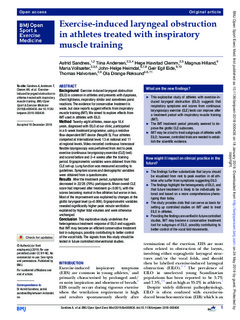| dc.contributor.author | Sandnes, Astrid | |
| dc.contributor.author | Andersen, Tiina Maarit | |
| dc.contributor.author | Clemm, Hege Synnøve Havstad | |
| dc.contributor.author | Hilland, Magnus | |
| dc.contributor.author | Vollsæter, Maria | |
| dc.contributor.author | Heimdal, John-Helge | |
| dc.contributor.author | Eide, Geir Egil | |
| dc.contributor.author | Halvorsen, Thomas | |
| dc.contributor.author | Røksund, Ola Drange | |
| dc.coverage.spatial | Norway | nb_NO |
| dc.date.accessioned | 2019-12-31T10:01:35Z | |
| dc.date.available | 2019-12-31T10:01:35Z | |
| dc.date.created | 2019-03-18T16:28:23Z | |
| dc.date.issued | 2019 | |
| dc.identifier.citation | Sandnes, A., et al. (2019). "Exercise-induced laryngeal obstruction in athletes treated with inspiratory muscle training." BMJ Open Sport Exerc Med 5(1): e000436. doi: 10.1136/bmjsem-2018-000436. | nb_NO |
| dc.identifier.issn | 2055-7647 | |
| dc.identifier.uri | http://hdl.handle.net/11250/2634519 | |
| dc.description.abstract | Background:
Exercise-induced laryngeal obstruction (EILO) is common in athletes and presents with dyspnoea, chest tightness, inspiratory stridor and sometimes panic reactions. The evidence for conservative treatment is weak, but case reports suggest effects from inspiratory muscle training (IMT). We aimed to explore effects from IMT used in athletes with EILO.
Method:
Twenty-eight athletes, mean age 16.4 years, diagnosed with EILO at our clinic, participated in a 6-week treatment programme, using a resistive flow-dependent IMT device (Respifit S). Four athletes competed at international level, 13 at national and 11 at regional levels. Video-recorded continuous transnasal flexible laryngoscopy was performed from rest to peak exercise (continuous laryngoscopy exercise (CLE) test) and scored before and 2-4 weeks after the training period. Ergospirometric variables were obtained from this CLE set-up. Lung function was measured according to guidelines. Symptom scores and demographic variables were obtained from a questionnaire.
Results:
After the treatment period, symptoms had decreased in 22/28 (79%) participants. Mean overall CLE score had improved after treatment (p<0.001), with the scores becoming normal in five athletes but worse in two. Most of the improvement was explained by changes at the glottic laryngeal level (p=0.009). Ergospirometric variables revealed significantly higher peak minute ventilation explained by higher tidal volumes and were otherwise unchanged.
Conclusion:
This explorative study underlines the heterogeneous treatment response of EILO and suggests that IMT may become an efficient conservative treatment tool in subgroups, possibly contributing to better control of the vocal folds. The signals from this study should be tested in future controlled interventional studies. | nb_NO |
| dc.description.sponsorship | Funding Major funding institutions: Haukeland University Hospital and University of Bergen. | nb_NO |
| dc.language.iso | eng | nb_NO |
| dc.publisher | BMJ | nb_NO |
| dc.rights | Navngivelse-Ikkekommersiell 4.0 Internasjonal | * |
| dc.rights.uri | http://creativecommons.org/licenses/by-nc/4.0/deed.no | * |
| dc.subject | CLE; EILO; continuous laryngoscopy exercise test; exercise; glottic; inspiratory muscle training; larynx; supraglottic; vocal cord dysfunction | nb_NO |
| dc.title | Exercise-induced laryngeal obstruction in athletes treated with inspiratory muscle training | nb_NO |
| dc.type | Journal article | nb_NO |
| dc.type | Peer reviewed | nb_NO |
| dc.description.version | publishedVersion | nb_NO |
| dc.rights.holder | © 2019 Author(s) (or their employer(s)) 2019. Re-use permitted under CC BY-NC. No commercial re-use. See rights and permissions. Published by BMJ. This is an open access article distributed in accordance with the Creative Commons Attribution Non Commercial (CC BY-NC 4.0) license, which permits others to distribute, remix, adapt, build upon this work non-commercially, and license their derivative works on different terms, provided the original work is properly cited, appropriate credit is given, any changes made indicated, and the use is non-commercial. See: http://creativecommons.org/licenses/by-nc/4.0/ . Notwithstanding the ProQuest Terms and Conditions, you may use this content in accordance with the terms of the License. | nb_NO |
| dc.source.pagenumber | 1-8 | nb_NO |
| dc.source.volume | 5 | nb_NO |
| dc.source.journal | BMJ Open sport & exercise medicine | nb_NO |
| dc.source.issue | 1 | nb_NO |
| dc.identifier.doi | 10.1136/bmjsem-2018-000436 | |
| dc.identifier.cristin | 1685694 | |
| cristin.unitcode | 1991,3,6,0 | |
| cristin.unitname | Avd Indremedisin | |
| cristin.ispublished | true | |
| cristin.fulltext | original | |
| cristin.qualitycode | 1 | |

